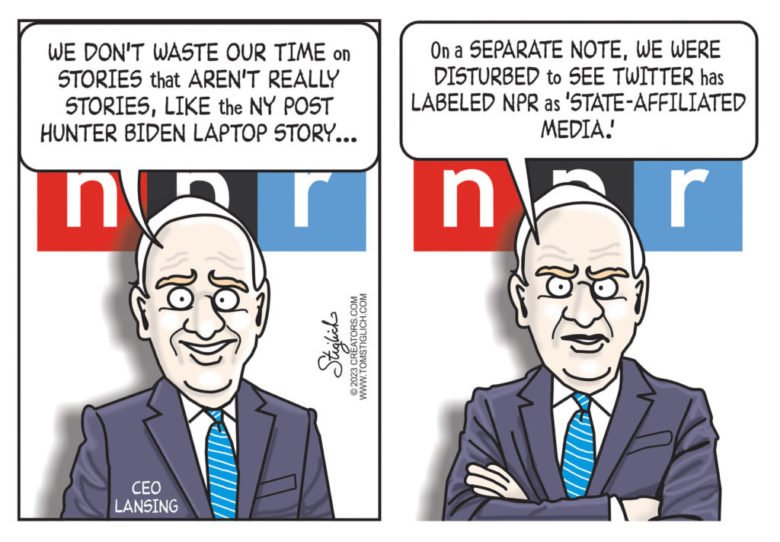Is NPR ‘State-Affiliated Media’? Their Coverage of the Federal Debt Certainly

In late December, after US Treasury Secretary Janet Yellen borrowed $90 billion in just one day, the federal government’s public debt eclipsed $34 trillion for the first time in history.
The steady accumulation of public debt has become a mainstay in modern America, seemingly as inevitable as death and taxes. But something strange happened when the US passed yet another trillion-dollar debt milestone.
“The federal debt starts the new year at a level that is hard to grasp: $34 trillion,” the New York Times declared in a piece titled “The Debt Matters Again,” and even “…federal deficits now look scarier.”
CNN, the Associated Press, and other legacy media outlets also reported on the debt situation, offering bleak soundbites.
“Unsustainable,” Marc Goldwein, senior vice president at the Committee for a Responsible Federal Budget, told the Washington Post while describing the situation.
“Dangerous… a truly depressing ‘achievement,’” said Maya MacGuineas, president of the Committee for a Responsible Federal Budget, in a CNN interview.
“Pretty grim,” Loyola Marymount University economics professor Sung Won Sohn told the Associated Press.
That legacy media are no longer shrugging off concerns about the federal debt is encouraging, if long overdue.
After all, it doesn’t take a PhD in economics to realize that racking up $34 trillion in debt — an amount 20 percent higher than the nation’s GDP, with a debt-to-GDP ratio higher than during World War II — is a serious problem.
Nothing to Fear?
Yet one media crown jewel informed listeners they had little to fear. NPR’s Leila Fadel asked Stephanie Kelton, a professor of economics at Stony Brook University, if Americans should “be afraid” of this mountain of red ink.
“No. They shouldn’t,” Kelton responded. “It’s the word debt that makes people afraid. And so when I think about this, you know, I look at this number, and I think, well, it’s just keeping track of our savings.”
The idea that debt is just “keeping track of our savings” is peculiar. But Kelton is a peddler of strange ideas.
For those who don’t know, Kelton, an advisor to Bernie Sanders during his 2016 presidential run, is a disciple of Modern Monetary Theory (MMT), a school of economics typically rejected (and often laughed at) by other economists.
MMT is distinguished from other economic schools of thought in that it posits that governments that issue fiat money don’t actually need to collect taxes to pay for their goods and services. As the New York Times stated in a 2022 profile of Kelton, “How will you pay for it?” is considered “a vapid policy question” in the MMT world. Things like budgeting are for cavemen.
In case you think I’m exaggerating, I’ll quote Kelton directly.
“[T]he idea that taxes pay for what the government spends is pure fantasy,” she writes in The Deficit Myth. “[I]t is the currency issuer — the federal government itself — not the taxpayer, that finances all government expenditures.”
Since the state can simply print money, its only real financial constraint is inflation, MMT proponents argue. This is, of course, true in a sense. Governments can print as much money as they want, but there is nothing profound or “modern” about this revelation.
‘The Carpenter Can’t Run Out of Inches’
China’s Song dynasty introduced paper money way back in the 10th century. Paper notes were convenient, and all went well initially because the notes were at first backed by coins made of precious metals. Things went south, however, when Chinese officials began printing notes that weren’t backed by coins. Hyperinflation ensued, and Song China was soon swallowed by the Mongol Empire.
History is replete with similar examples, most recently in Argentina, where Peronists for years tried to solve its social problems by printing money.
Inflation is a curse. And MMT is a recipe for hyperinflation, as Harvard economist and former Clinton Treasury Secretary Lawrence Summers has noted, along with countless other economists.
The economics of this are not complex. Every economist knows there’s no such thing as a free lunch. Printing mass amounts of money cannot solve the problem of scarcity. This fundamental economic reality, that we have limited resources and limitless wants, seems lost on Kelton.
“The carpenter can’t run out of inches,” she tweeted in 2019. “The stadium can’t run out of points. The airline can’t run out of [frequent flier] miles. And the USA can’t run out of dollars.”
Kelton’s tweet reflects a fundamental misunderstanding of scarcity.
A carpenter might not be able to run out of inches, but he can run out of lumber and nails. Airlines might not be able to run out of frequent flier miles, but they can run out of seats and fuel, something better economists than Kelton have pointed out.
The ‘Court…
Read More: Is NPR ‘State-Affiliated Media’? Their Coverage of the Federal Debt Certainly

